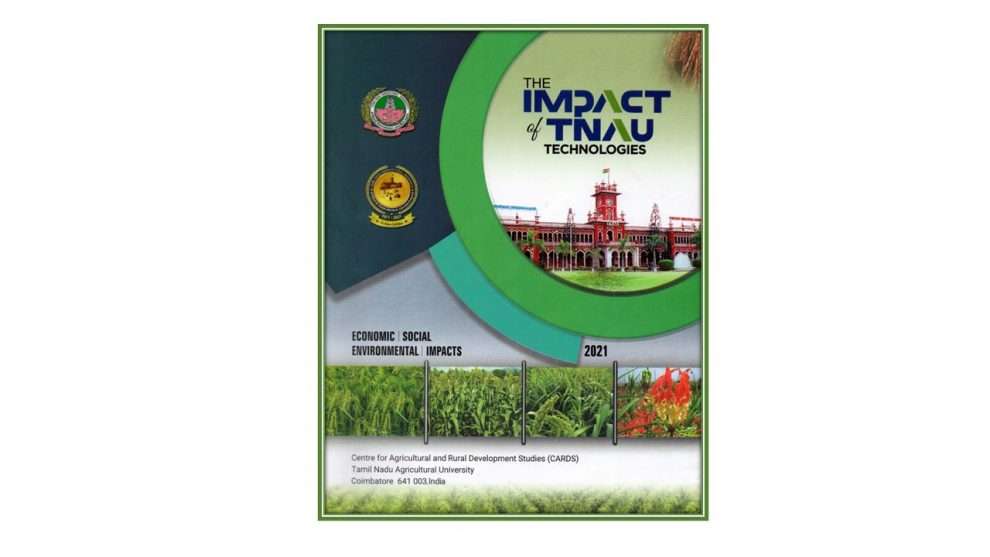Centre for Agricultural and Rural Development Studies Tamil Nadu Agricultural Universities, Coimbatore
Publisher: Madras Agricultural Students Union (MASU)
First Edition: 2021
Pages: 103
ISBN: 978-81-954654-4-6
Agriculture R&D has a crucial role in developing new knowledge that is critical for enhancing the efficiency of farming. Both the government and the private sector invest in agricultural R&D to develop different types of knowledge which include new technologies/solutions that can enhance productivity and address specific challenges, including institutional and policy reforms. Returns to investment is currently a major tool that can decide where and how much to invest, and this has also become an important means to demonstrate the impact of research. It is not that easy to capture the scale and returns on research investment in agriculture and allied sectors in quantitative terms due to the diversity and extent of the domain. Under such a scenario, we must appreciate the efforts of the Centre for Agricultural and Rural Development Studies (CARDS), Tamil Nadu Agricultural University (TNAU), in assessing the impact of technologies developed over the last 50 years.
This book provides details about socio-economic and environmental impacts of TNAU technologies under three broad categories, viz., new crop varieties, crop management technologies and agricultural implements and machinery covering 581 varieties, 104 technologies and 57 agricultural implements and machines. They have adopted the theory of change framework to capture the key returns and scale from the technologies developed. It is very challenging to assemble the meta data of these technologies over a period, but CARDS has adopted a wide range of approaches, such as expert consultation meetings, literature survey and systematic review, farm level survey, key informant survey, and case studies to assess the interventions. Using CSPro application (CSPro Software (census.gov)) the data has been collected under the guidance of the International Crops Research Institute for the Semi-Arid Tropics (ICRISAT). The impact of technologies is assessed by adopting relevant analytical tools. Brain storming sessions and zonal workshops with key officials, experts and other actors related to agriculture and allied sectors from within and outside the state were conducted to validate the results of the study.
In brief, the book highlights the extensive work that TNAU has done – for example, TNAU varieties occupy 24.78 lakh hectare (45%) out of 55.26 lakh hectare of gross cropped area, its technologies cover 86% of gross cropped area, and machines cover 16% of gross cropped area in Tamil Nadu. TNAU technologies have contributed an incremental benefit of INR 10,433 crores/annum in the gross value of output. The technologies developed and disseminated have contribution towards nutritional security, improved the standard of living of farmers, and promoted private capital formation. The adoption of some of the ecofriendly TNAU technologies have resulted in reduction in agrochemical use, reduction of Environmental Impact Quotient (EIQ) values, boosted water and resource conservation and adaptation to climate resilience.
The book also covers the spillover effect of TNAU technologies in different parts of India and documented certain milestone technologies such as biopesticides, biofertilizers that have generated high revenue for years. The book also talks of how the technologies developed have contributed towards meeting the Sustainable Development Goals (SDGs).
Further on the book provides a detailed account of scale of TNAU technological impact on the farmers and the economy of the state. Though it is challenging to cover such a wide range of technologies, the effort in assessing the technological impact is worth applauding. However, it is also equally important for an institution to capture the complex institutional changes that an innovation or a technology result in, rather than just providing a linear assessment of the technologies. Unless we understand the channel or mechanism through which the technology affects farmers, the actors involved, the distribution of costs and returns of the new technology across these actors, these studies will often fail to provide any policy input as to how research should be organized better if the enhanced impact is to be achieved. These studies, in essence, will limit themselves to the purpose of showcasing what has been achieved with little guidance on what can be improved.
Also, there are several institutional initiatives that do not necessarily generate direct revenue for farmers, but still impacts the way the system works and its efficiency, but will not have a standard guideline. Most of these problems can be classified as ‘wicked problems’, it is challenging and often insufficient to only present the impact as there are complex pathways and a range of actors. It becomes always important to assess the returns along with the resulting change in the system if more investments are to be pulled in and for more refined future research.
Along with the impact, it is important to understand and provide the SWOT and lessons learnt during the technological development and dissemination process which can complement the impact. This will help in providing more relevant insights for institutional reforms in research and the wider agricultural innovation system (AIS) of which Research is an important domain. Further, when impact studies are carried out by the same institute which developed the technologies being assessed, objectivity and credibility will be questioned. It is also true that Social Science departments in research institutes and universities are expected to assess the impact and more often than not mandated to carry out such studies. In such conditions, researchers can establish credibility in the following ways: 1) use econometric tools to assess impact to minimize bias; 2) thick description of sampling and the analytical methods employed; and 3) using a mixed method approach to better explain the results. These elements can enrich the utility of these studies. Having said that, the present report deserves appreciation for comprehensively documenting and analyzing the impact of selected technologies.
Finally, in today’s competitive world, most decisions on investments hinge on returns to that investment. Adopting such technological assessment practices of CARDS, TNAU– through agriculture and allied sector organizations– may help to develop overall understanding of technological change as well as to quantify the welfare effects over time. It can also be a good source to showcase the organization’s research achievements regarding the farming community that remain unnoticed. Future researchers can always use this as a reference for an historical overview. It can serve as a preliminary source to justify the returns to research investment for investors (public/private/national/international). It is a good read for anyone who wants to get a brief overview of the technologies developed by TNAU and their welfare implications. It will be more useful prescriptively, both for policy and extension, if one could add a holistic, system perspective on the mechanism of impact and institutional dynamics.
Bhuvana N & Aditya KS

Bhuvana N, is a Consultant at the Centre for Research on Innovation and Science Policy (CRISP), Hyderabad. She has a PhD in Agricultural Extension, from Professor Jayashankar Telangana State Agricultural University, Hyderabad. Her research interests include organizational ecosystems and effectiveness, social networks and technological change. She can be reached at: bhuvanaditya7@gmail.com
 Aditya KS is a PhD Scholar at Humboldt University, Berlin, Germany, and a Fellow of Netaji Subhas ICAR-International Fellowship. He is also a Scientist (Agricultural Economics) at the ICAR-Indian Agricultural Research Institute, New Delhi. His research interests: impact assessment of agricultural technologies and natural resource economics. He can be reached at: adityaag68@gmail.com.
Aditya KS is a PhD Scholar at Humboldt University, Berlin, Germany, and a Fellow of Netaji Subhas ICAR-International Fellowship. He is also a Scientist (Agricultural Economics) at the ICAR-Indian Agricultural Research Institute, New Delhi. His research interests: impact assessment of agricultural technologies and natural resource economics. He can be reached at: adityaag68@gmail.com.





Very laudable effort by TNAU in assessing the socio-economic and environmental impact of its new crop varieties, management technologies and machines and implements during the last 50 years. The impacts are significant. But as authors have observed that more need to be done in terms of capturing the institutional changes that occurred during the technological changes so that higher investments, policy reforms for still higher and wider impacts could be possible. Such impact analysis should be attempted regularly by other AUs also for attracting higher investments for ARD and through that improved living and livelihoods for farmers. As observed by reviewers, meta data collection and documentation should also receive due attention for quality impact analysis. The reviewers have done a good job in suggesting improvements in impact studies for better research and policy making.